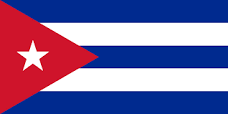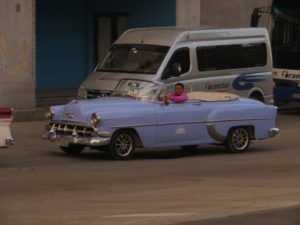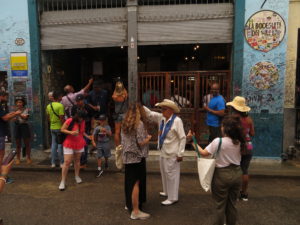
Only 90 miles from our shores, Cuba might as well be half a world away. It is a beautiful island known for its fine cigars, rum, and coffee. I have sampled two of the three. I went on a three hour walking tour of Old Havana. The centuries old Spanish architecture is evident. Sadly, many of the buildings are run down but the government has recently permitted foreign investment that has refurbished some of the grand old hotels in the area and they are beautifully done. Many are owned by the government as are many businesses. With welcoming outdoor cafe areas, I imagine it would be a nice place to spend a few weeks to explore the country side and get to know some of the Cuban people.
 Alas, however, we were not permitted to spend any money at any of those places. We could only patronize shops owned and operated by local people, not the government. Prohibited not by the Cuban government but rather by the United States government. We were told by the tour guide that approximately 57% of Cuba’s annual budget goes directly to the military. As a result, the USA reasons that spending money at government owned establishments directly funds the Cuban military and therefore the US government bans Americans from spending money that supports the military. Sadly, we walked by beautiful establishments that would have been wonderful to sit, sip a brew and watch the world go by.
Alas, however, we were not permitted to spend any money at any of those places. We could only patronize shops owned and operated by local people, not the government. Prohibited not by the Cuban government but rather by the United States government. We were told by the tour guide that approximately 57% of Cuba’s annual budget goes directly to the military. As a result, the USA reasons that spending money at government owned establishments directly funds the Cuban military and therefore the US government bans Americans from spending money that supports the military. Sadly, we walked by beautiful establishments that would have been wonderful to sit, sip a brew and watch the world go by.

The people of Cuba couldn’t be more welcoming. I marvel at how friendly and happy they seem to be even under the weight of a socialist regime. As a rare political side note by me, people in the United States would be far less enthralled by socialism if they actually saw the result of such a system in person. It’s heart-breaking. The military has such a stranglehold on everything that the people are powerless to force change. At one time, Cuba supplied 90% of the world’s sugar. Last year they had to import sugar because of the flight by farmers to the cities looking for jobs. Few want to farm anymore; the government takes anywhere from 60-75% of the milk, meat, and crops the farmers produce. There is no incentive to be a producer.
Because of the flight from the farms to the cities, when the Soviet Union fell and the flow of aid ceased, the people of Cuba starved. During the 1990s famine spread across the country and epidemics were rampant. For a people just 90 miles south of the United States, I don’t understand how we could standby and do nothing to help. Sure some sanctions were lifted and private organizations had permission to send supplies but surely the United States should have been more compassionate and humane during that crisis. The recent chaos of the socialist government in Venezuela, another Cuban ally, has further exacerbated the situation in Cuba.
Cuba has a troubled and complicated history that is hard to fathom in just a three hour tour. But there is little doubt in my mind that the efforts of the United States to put pressure on the Castro regime has done little more than oppress the wonderful people of Cuba. Food for the average Cuban is rationed; our guide told us he is allowed to purchase 5 eggs per month for each person in his family–he has a wife and two small children–do the math. He showed us his ration card where his food purchases limited, tallied after each purchase, and must be kept within his allotment. On the other hand, the military hardly feels the pinch as they take what they need, eat well, and military personnel earn TWICE the wage as private citizens (if private citizens can even find jobs). In 2017, the National Bureau of Statistics and Information reported the average Cuban earned the equivalent of $29 per month. One woman said, “If you buy food you can not buy clothes, if you buy clothes you can not eat, we live every day thinking about how to come up with ways survive,” Many survive either by stealing from the government or by receiving “remittances” from relatives who live abroad (which are taxed by the government !).
All things considered, I was glad I went. Each trip abroad gives me a better perspective of how fortunate we are in the United States. Inevitably, I feel for the people of countries like Cuba. I repeatedly hear people for a number of countries I have visited say, “We love the American people, we just can’t stand your government.” Sad.
Turning to cigars and rum: I bought a box of Cohiba Robustos and a bottle of Havana Club rum–both recommended by the tour guide as the best the country has to offer. In all honesty, a Dominican Dunhill, Davidoff, Macanudo, or Rocky Patel (particularly with Connecticut shade tobacco wrappers) are superior to Cuban Cohibas. Nicaraguan Flor de Cana 18 year rum is far and away much smoother than Havana Club rum.
In short, I would love to go back to Cuba and continue conversations with the Cuban people, but don’t need to go for cigars or rum !

